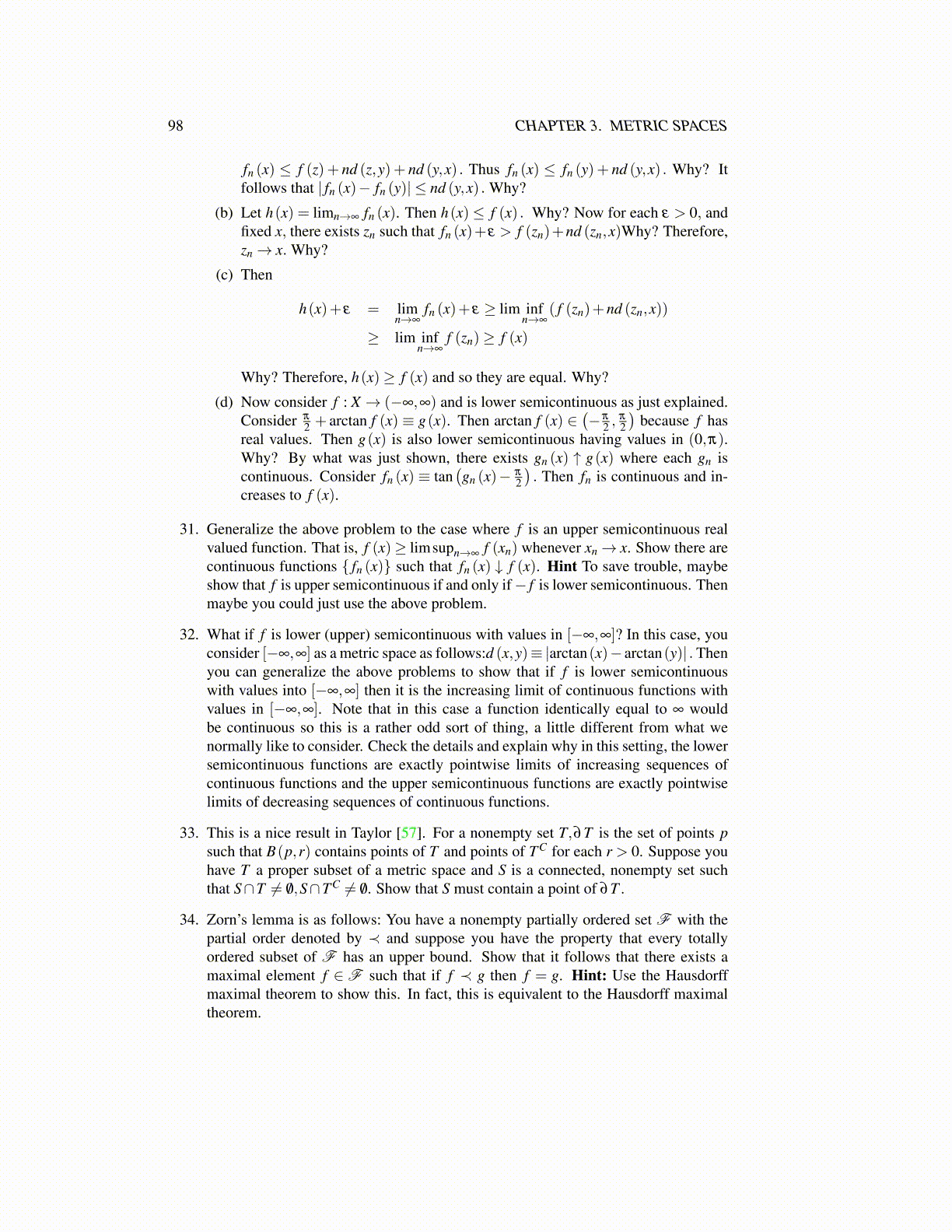
98 CHAPTER 3. METRIC SPACES
fn (x) ≤ f (z)+ nd (z,y)+ nd (y,x) . Thus fn (x) ≤ fn (y)+ nd (y,x) . Why? Itfollows that | fn (x)− fn (y)| ≤ nd (y,x) . Why?
(b) Let h(x) = limn→∞ fn (x). Then h(x)≤ f (x) . Why? Now for each ε > 0, andfixed x, there exists zn such that fn (x)+ε > f (zn)+nd (zn,x)Why? Therefore,zn→ x. Why?
(c) Then
h(x)+ ε = limn→∞
fn (x)+ ε ≥ lim infn→∞
( f (zn)+nd (zn,x))
≥ lim infn→∞
f (zn)≥ f (x)
Why? Therefore, h(x)≥ f (x) and so they are equal. Why?
(d) Now consider f : X → (−∞,∞) and is lower semicontinuous as just explained.Consider π
2 + arctan f (x) ≡ g(x). Then arctan f (x) ∈(−π
2 ,π
2
)because f has
real values. Then g(x) is also lower semicontinuous having values in (0,π).Why? By what was just shown, there exists gn (x) ↑ g(x) where each gn iscontinuous. Consider fn (x) ≡ tan
(gn (x)− π
2
). Then fn is continuous and in-
creases to f (x).
31. Generalize the above problem to the case where f is an upper semicontinuous realvalued function. That is, f (x)≥ limsupn→∞ f (xn) whenever xn→ x. Show there arecontinuous functions { fn (x)} such that fn (x) ↓ f (x). Hint To save trouble, maybeshow that f is upper semicontinuous if and only if− f is lower semicontinuous. Thenmaybe you could just use the above problem.
32. What if f is lower (upper) semicontinuous with values in [−∞,∞]? In this case, youconsider [−∞,∞] as a metric space as follows:d (x,y)≡ |arctan(x)− arctan(y)| . Thenyou can generalize the above problems to show that if f is lower semicontinuouswith values into [−∞,∞] then it is the increasing limit of continuous functions withvalues in [−∞,∞]. Note that in this case a function identically equal to ∞ wouldbe continuous so this is a rather odd sort of thing, a little different from what wenormally like to consider. Check the details and explain why in this setting, the lowersemicontinuous functions are exactly pointwise limits of increasing sequences ofcontinuous functions and the upper semicontinuous functions are exactly pointwiselimits of decreasing sequences of continuous functions.
33. This is a nice result in Taylor [57]. For a nonempty set T,∂T is the set of points psuch that B(p,r) contains points of T and points of TC for each r > 0. Suppose youhave T a proper subset of a metric space and S is a connected, nonempty set suchthat S∩T ̸= /0,S∩TC ̸= /0. Show that S must contain a point of ∂T .
34. Zorn’s lemma is as follows: You have a nonempty partially ordered set F with thepartial order denoted by ≺ and suppose you have the property that every totallyordered subset of F has an upper bound. Show that it follows that there exists amaximal element f ∈ F such that if f ≺ g then f = g. Hint: Use the Hausdorffmaximal theorem to show this. In fact, this is equivalent to the Hausdorff maximaltheorem.